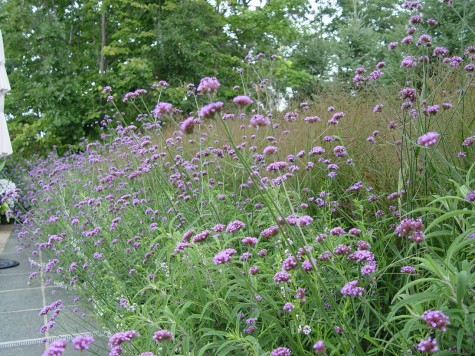
There are those clients that love that grassy, wispy, pastel and herb look. For lack of a better term, I call these my “roadside” weed plantings. As pale and fragile as they appear, they just hit their stride as the summer begins to wind down. Cooler night temperatures don’t faze them one bit. One of my most favorite weedy combinations-the big wispy species, verbena bonariensis, and an ornamental grass.
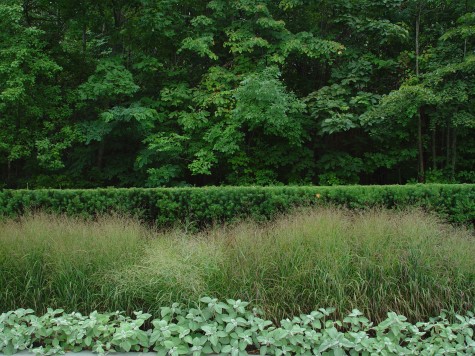 I am a fan of ornamental grasses-espcially the thin bladed wiry types that stand up well. This hedge of panicum virgatum is a welcome textural change from the dark stiffly formal yew hedge pictured above. When I add verbena bonariensis in front of this grass, something good starts cooking. It might very well be that orangy cast typical of a panic grass setting seed; the lavender verbena flowers seem more intensely lavender.
I am a fan of ornamental grasses-espcially the thin bladed wiry types that stand up well. This hedge of panicum virgatum is a welcome textural change from the dark stiffly formal yew hedge pictured above. When I add verbena bonariensis in front of this grass, something good starts cooking. It might very well be that orangy cast typical of a panic grass setting seed; the lavender verbena flowers seem more intensely lavender.
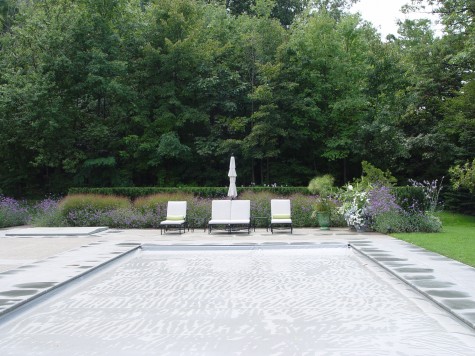 This simple and soft flower/grass hedge transforms a strictly formal evergreen garden for the summer months. Running the entire length of the landscape on both ends of the pool, its cloud-like appearance is on one hand in stark contrast to the modern chaises, and on the other, friendly in feeling and color to the loosely planted pots.
This simple and soft flower/grass hedge transforms a strictly formal evergreen garden for the summer months. Running the entire length of the landscape on both ends of the pool, its cloud-like appearance is on one hand in stark contrast to the modern chaises, and on the other, friendly in feeling and color to the loosely planted pots.
 Alyssum, lavender, silver posie thyme and tricolor sage make a pale ruff around a blue foliaged escheveria in this old stone box. The peach flowers of the echeveria-a bonus. Though delicate in appearance, these plants are drought and frost resistant. It interests me that something so fragile in appearance can withstand hit-and-miss care. Plant combinations such as this one are as foolproof as they come. Deadhead the lavender, and shear the alyssum once in a while-that’s all. Their only enemy-too much water.
Alyssum, lavender, silver posie thyme and tricolor sage make a pale ruff around a blue foliaged escheveria in this old stone box. The peach flowers of the echeveria-a bonus. Though delicate in appearance, these plants are drought and frost resistant. It interests me that something so fragile in appearance can withstand hit-and-miss care. Plant combinations such as this one are as foolproof as they come. Deadhead the lavender, and shear the alyssum once in a while-that’s all. Their only enemy-too much water.
 jjThere are other grey foliaged plants that are just as rugged. Though I am not so fond of the cut-leaf annual dusty miller, the paddle shaped leaves of cirrus dusty miller I find very appealing. The texture of simple shaped leaves, repeated in a smaller version with the silver helicrysum, is a great contrast to the needle foliaged icicle plant. The saucy and ferny foliaged plant in the center-a silver centaurea. Only the white nicotiana in this basket would fuss if you forgot to water.
jjThere are other grey foliaged plants that are just as rugged. Though I am not so fond of the cut-leaf annual dusty miller, the paddle shaped leaves of cirrus dusty miller I find very appealing. The texture of simple shaped leaves, repeated in a smaller version with the silver helicrysum, is a great contrast to the needle foliaged icicle plant. The saucy and ferny foliaged plant in the center-a silver centaurea. Only the white nicotiana in this basket would fuss if you forgot to water.
 The trailing plant front and center in this pot-showy oregano. Though they show poorly in pots early on, they fill out beautifully. The papery bracts are the palest green, lavender and peach.
The trailing plant front and center in this pot-showy oregano. Though they show poorly in pots early on, they fill out beautifully. The papery bracts are the palest green, lavender and peach.
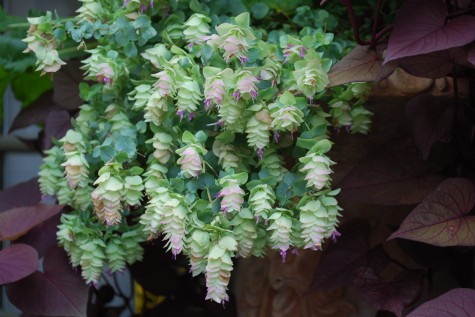
Once you have seen Kent Beauty oregano, you will want to grow it.
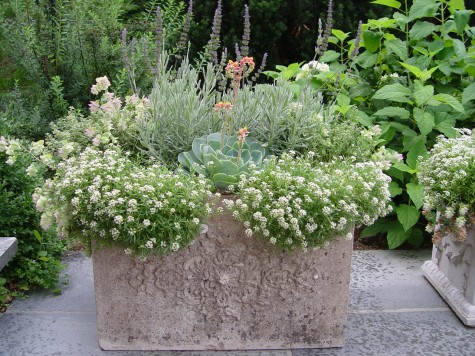 These plants are fairly diminuitive growers, so not so much grooming and shaping is necessary. Though it is late summer, no plant is overgrown, or threatening the well-being of a neighbor. This pot has shown well the better part of four months.
These plants are fairly diminuitive growers, so not so much grooming and shaping is necessary. Though it is late summer, no plant is overgrown, or threatening the well-being of a neighbor. This pot has shown well the better part of four months.
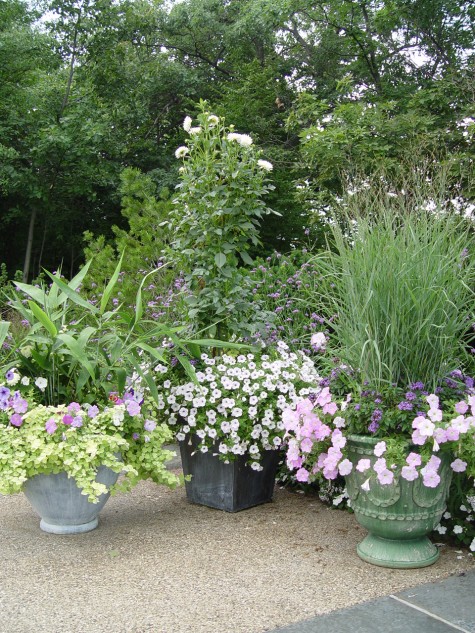
The big pots have grass, a broad leaved bamboo, and a tall dahlia as centerpieces. The pastel petunias have that same loose weedy look as the grassy beds. One would never suspect this planting was photographed in late September. This pleases me, as I so hate to see a season come to a close.
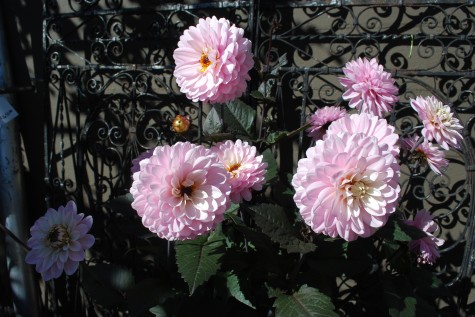
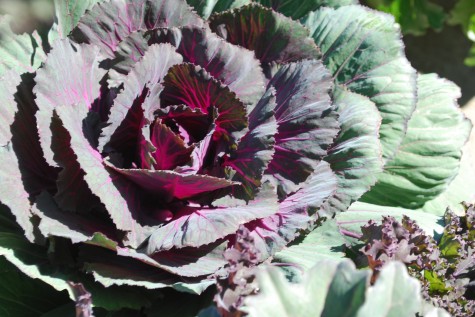
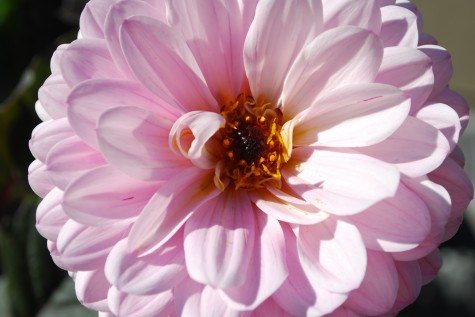

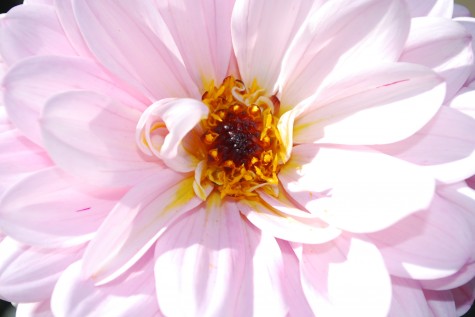

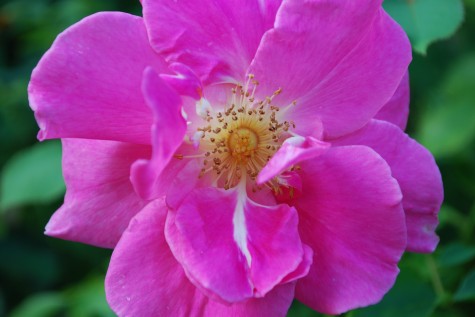
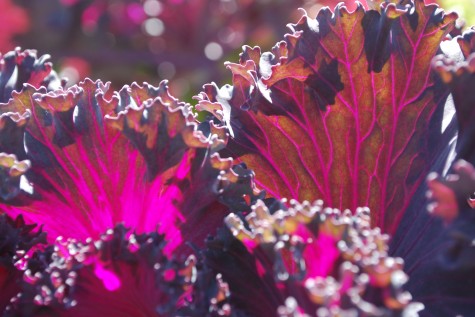
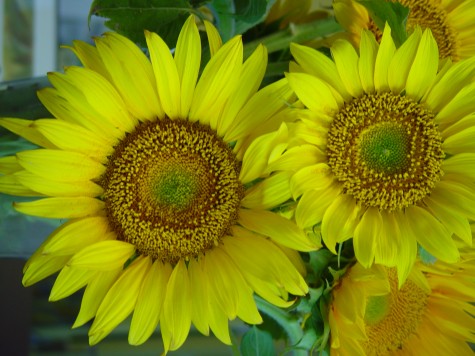

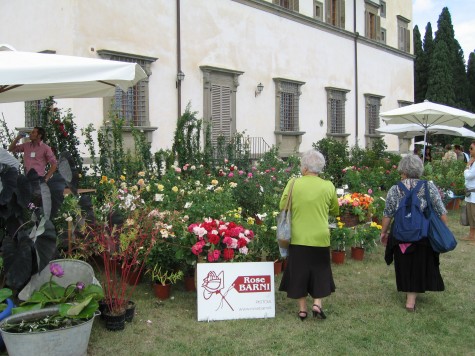
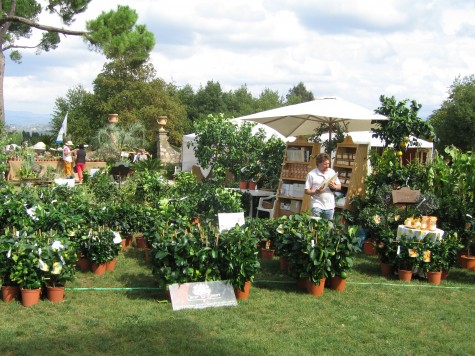 Fruit trees, fruiting shrubs and grape vines were represented in lots of varieties. We plan to offer fruiting trees, shrubs and grapevines at the store this coming spring, as Rob’s memory of this fair is a strong and good one. My favorite-the fruit cocktail trees, with 5 varieties of apples or pears, grafted onto a single rootstock. The idea of this appeals to my idea of gardening fun and festivity. I would have loved trees like this as a child, and I still do.
Fruit trees, fruiting shrubs and grape vines were represented in lots of varieties. We plan to offer fruiting trees, shrubs and grapevines at the store this coming spring, as Rob’s memory of this fair is a strong and good one. My favorite-the fruit cocktail trees, with 5 varieties of apples or pears, grafted onto a single rootstock. The idea of this appeals to my idea of gardening fun and festivity. I would have loved trees like this as a child, and I still do. 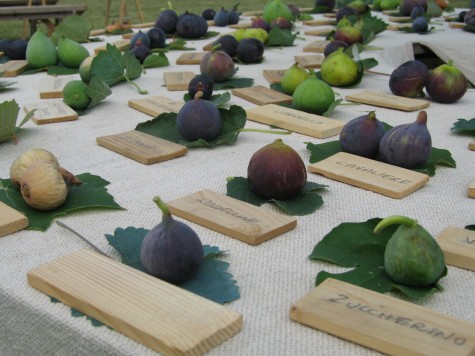 This display of different varieties of figs-more fun. How better to choose a fig tree than to have the fruit in front of you to hold, smell, and see? I do have a client of Italian descent growing fig trees; her love of gardening, growing food and cooking she inherited from her grandfather. One of his grapevines now grows in her garden. She is willing to bury her fig trees in compost for the winter-this tells you how much she wants them. How I envy the Italian climate such that they can grow figs, lemons and limes.
This display of different varieties of figs-more fun. How better to choose a fig tree than to have the fruit in front of you to hold, smell, and see? I do have a client of Italian descent growing fig trees; her love of gardening, growing food and cooking she inherited from her grandfather. One of his grapevines now grows in her garden. She is willing to bury her fig trees in compost for the winter-this tells you how much she wants them. How I envy the Italian climate such that they can grow figs, lemons and limes. 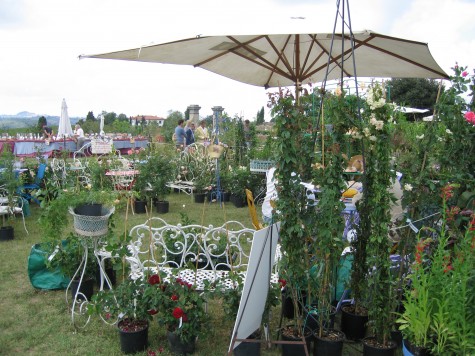 The little of this and some of that quality of this fair is engaging and charming. This is my favorite time of year for my own farmer’s market. The produce and fruit is as beautiful to look at, as it is to eat. The bunches of cut flowers, grass bouquet’s, the evidence of the summer harvest, speaks to much about why I garden. Making something grow is just plain satisfying.
The little of this and some of that quality of this fair is engaging and charming. This is my favorite time of year for my own farmer’s market. The produce and fruit is as beautiful to look at, as it is to eat. The bunches of cut flowers, grass bouquet’s, the evidence of the summer harvest, speaks to much about why I garden. Making something grow is just plain satisfying. The apples and pears have the spots, dings and scars that come with naturally grown fruit. Years ago I owned five acres that came with 20 fruit trees. I would pick the fruit warm from the sun and eat right then and there-around the spots if need be. This is a version of fine dining that I like.
The apples and pears have the spots, dings and scars that come with naturally grown fruit. Years ago I owned five acres that came with 20 fruit trees. I would pick the fruit warm from the sun and eat right then and there-around the spots if need be. This is a version of fine dining that I like. 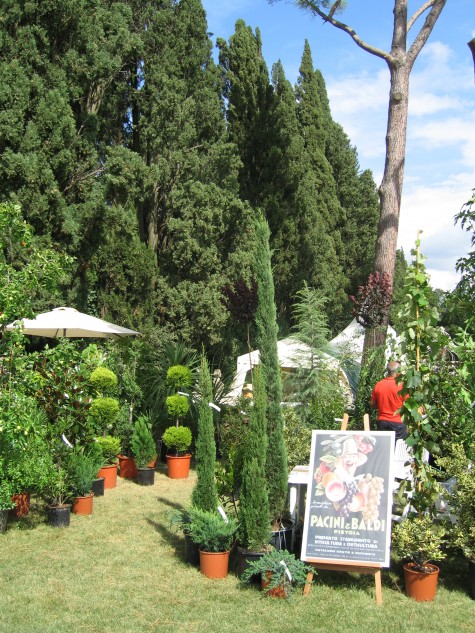
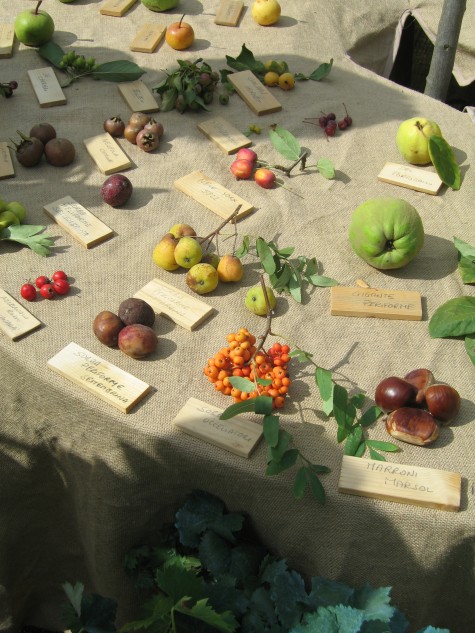 I am able to buy and eat food that cannot be grown where I live. I am glad I do not have to do without figs, lemons and mangoes. But Rob’s pictures make me wish I had been there.
I am able to buy and eat food that cannot be grown where I live. I am glad I do not have to do without figs, lemons and mangoes. But Rob’s pictures make me wish I had been there.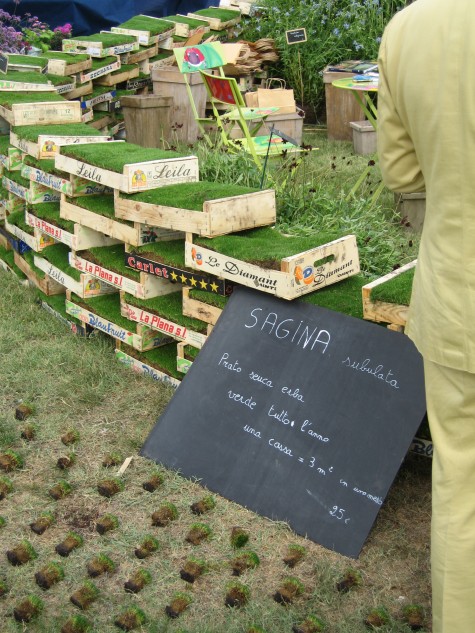 This is my favorite display-sagina subulata grown in fruit boxes. What a gorgeous look. This I could easily do. I might even like to just grow it in boxes. What would never occur to me to do-display the spacing layout on the ground. The sign says one box will get you three square meters of Sagina; if you don’t believe it, look here.
This is my favorite display-sagina subulata grown in fruit boxes. What a gorgeous look. This I could easily do. I might even like to just grow it in boxes. What would never occur to me to do-display the spacing layout on the ground. The sign says one box will get you three square meters of Sagina; if you don’t believe it, look here. 
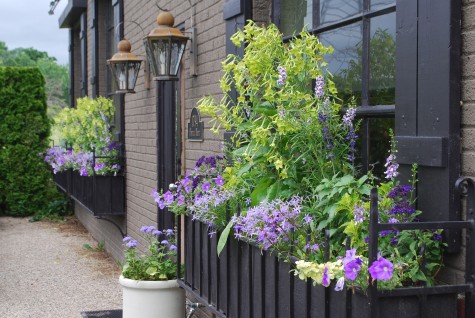
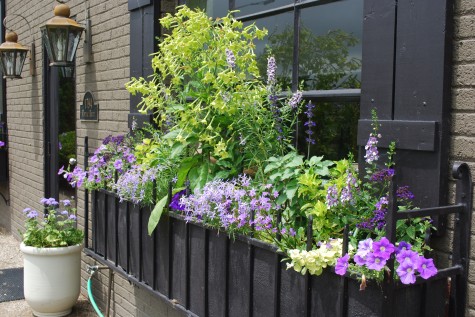 No matter what you fancy in your garden, nothing in it ever stands still. A garden actively grows, or actively sulks, or goes down. Some days I wish I could shift into neutral and coast, but I know better. I also know that as much as I would want to devote a chunk of time to nurturing all my plants, every day, that rarely happens. I have a demanding work life; moving that along every day takes priority. I hedge my bets some with plants that seem to handle the hit and miss nature of my care. Petunias thrive on this treatment; this is one plant that the more I fuss with them, the more they resent it. A trim once in a while is enough. Angelonia does not like cold weather, but it’s not a prima donna either. Once the hot weather comes, they come on strong.
No matter what you fancy in your garden, nothing in it ever stands still. A garden actively grows, or actively sulks, or goes down. Some days I wish I could shift into neutral and coast, but I know better. I also know that as much as I would want to devote a chunk of time to nurturing all my plants, every day, that rarely happens. I have a demanding work life; moving that along every day takes priority. I hedge my bets some with plants that seem to handle the hit and miss nature of my care. Petunias thrive on this treatment; this is one plant that the more I fuss with them, the more they resent it. A trim once in a while is enough. Angelonia does not like cold weather, but it’s not a prima donna either. Once the hot weather comes, they come on strong. 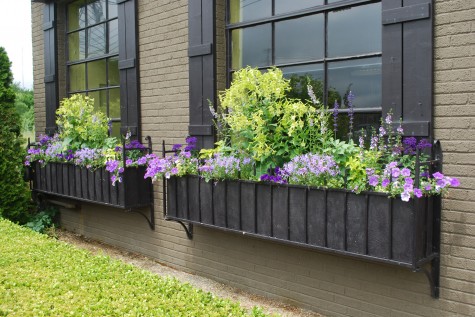 Blue salvia is puny early on; it is a late season annual. In a good year, they handle cooling fall temperatures with aplomb. I knew I would have these late. Planting the blue star-flowered laurentia was risky. Not only am I not so familiar with its habit, it has that look of an early season annual destined to peter out. This I cannot really explain, except to say some plants just look like they won’t do. The heliotrope was stuck in first gear; this plant likes hot weather. But for the moment, the lime nicotiana alata has my attention; the weather was instrumental in making it look perfectly happy. Every year, the weather is perfect for something; I thus follow the National Weather Service three month predictions with a lot of interest in late winter. Occasionally that helps.
Blue salvia is puny early on; it is a late season annual. In a good year, they handle cooling fall temperatures with aplomb. I knew I would have these late. Planting the blue star-flowered laurentia was risky. Not only am I not so familiar with its habit, it has that look of an early season annual destined to peter out. This I cannot really explain, except to say some plants just look like they won’t do. The heliotrope was stuck in first gear; this plant likes hot weather. But for the moment, the lime nicotiana alata has my attention; the weather was instrumental in making it look perfectly happy. Every year, the weather is perfect for something; I thus follow the National Weather Service three month predictions with a lot of interest in late winter. Occasionally that helps. 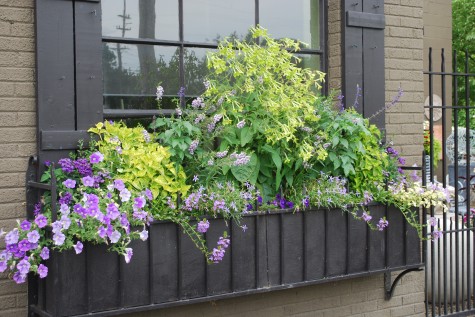 By August first, we were getting an 80 degree day once in a while. You can see the effect on the licorice and heliotrope; too little heat, too late. The flowering on the laurentia is slowing down, as I thought it would. Though the flowering is so- so, the plants are growing fine. The overall shape and the interaction of the group is the success of the box. Cool and dry made for unusually few bugs and no disease .
By August first, we were getting an 80 degree day once in a while. You can see the effect on the licorice and heliotrope; too little heat, too late. The flowering on the laurentia is slowing down, as I thought it would. Though the flowering is so- so, the plants are growing fine. The overall shape and the interaction of the group is the success of the box. Cool and dry made for unusually few bugs and no disease . By early September, my balanced box has gone too tall-bad maintenance on my part. Trimming plants back keeps them stocky, and encourages them to reflower. However, this height is a great look from the street; the flowers are visible over the boxwood.
By early September, my balanced box has gone too tall-bad maintenance on my part. Trimming plants back keeps them stocky, and encourages them to reflower. However, this height is a great look from the street; the flowers are visible over the boxwood.  As I predicted, the laurentia bloomed out, and needs replacing. By September 15, our weather is in transition. I expect night temperatures in the high forties this week yet. However, I am not willing to rip the boxes yet; I hold on to my summer season as long as I can. We are having our warmest daytime temperatures of the season. As there are plenty of plants that thrive in cool night temperatures, I will replace as needed.
As I predicted, the laurentia bloomed out, and needs replacing. By September 15, our weather is in transition. I expect night temperatures in the high forties this week yet. However, I am not willing to rip the boxes yet; I hold on to my summer season as long as I can. We are having our warmest daytime temperatures of the season. As there are plenty of plants that thrive in cool night temperatures, I will replace as needed. 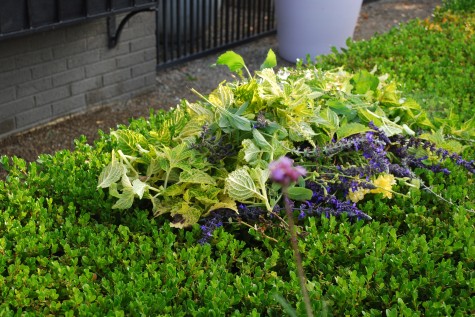 A good haircut and deadheading came first; late is better than never. As long as the warm weather holds, the coleus will respond quickly to the trim. There is no reason to give up what you have looked after all season. There is every good reason to keep what is good, and replace what isn’t.
A good haircut and deadheading came first; late is better than never. As long as the warm weather holds, the coleus will respond quickly to the trim. There is no reason to give up what you have looked after all season. There is every good reason to keep what is good, and replace what isn’t.